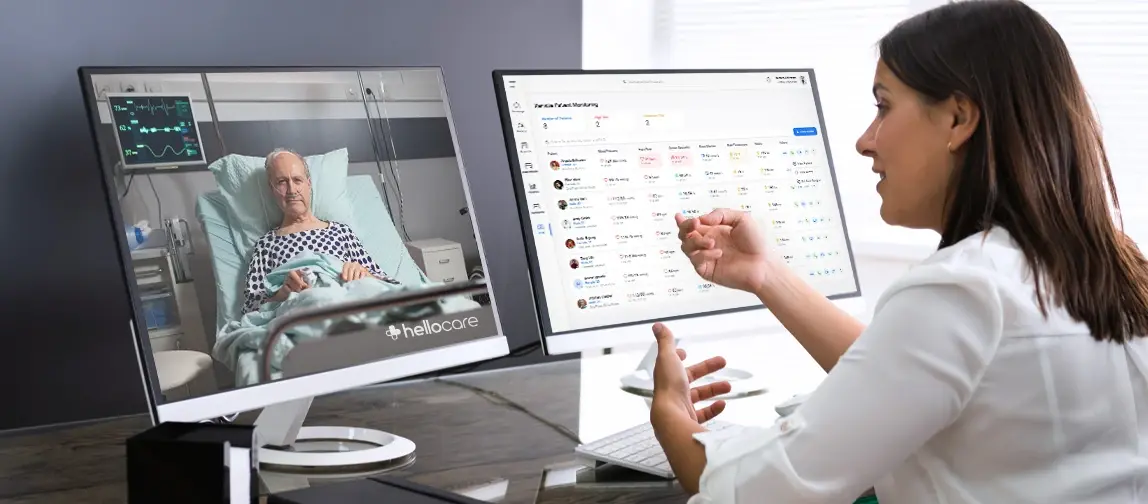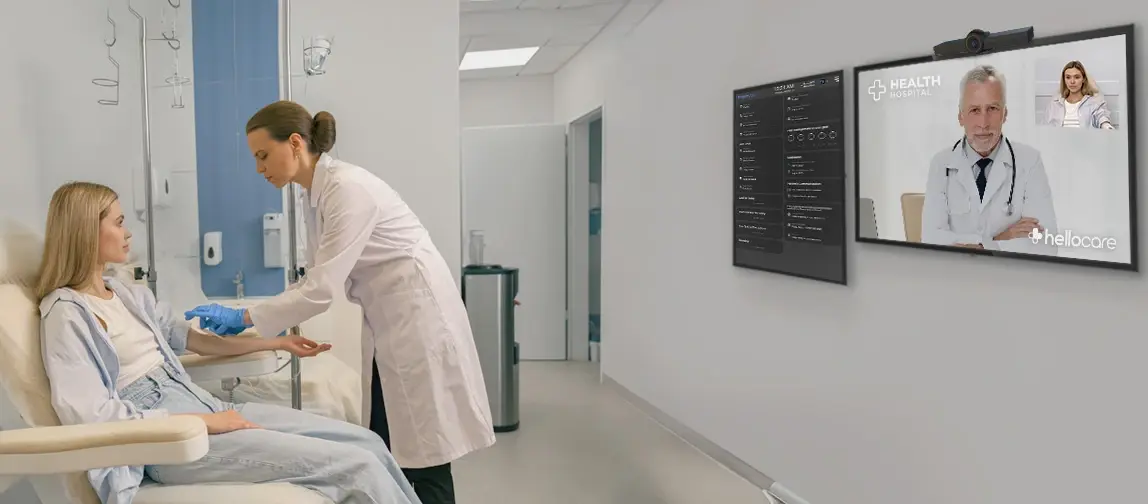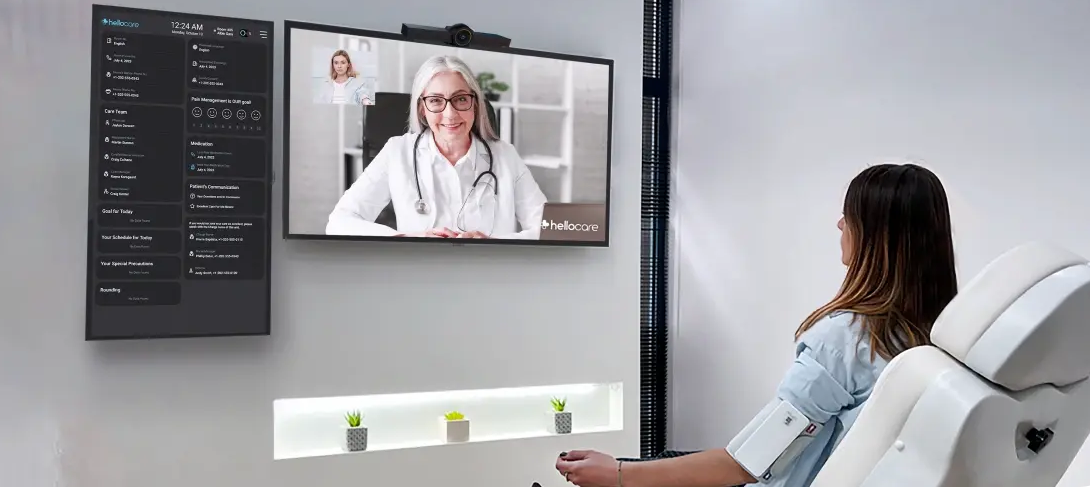Redefining Healthcare
AI-Assisted Virtual Nursing
June 25, 2024 3:15:29 PM
.webp)
In the ever-evolving landscape of healthcare, a quiet revolution is taking place, one that might not be
immediately visible to the casual observer but is nonetheless reshaping the very fabric of care
delivery.
It's the rise of virtual nursing, a concept that, while once might have been relegated to the realm of
science fiction,
is now a tangible, impactful reality, altering the way healthcare professionals work and patients
receive care.
Imagine a world where nurses, the unsung heroes of healthcare, are not only present at the bedside but also extend their reach through digital means, offering expertise and comfort from miles away. This is the world of virtual nursing. The idea stemmed from a necessity, a response to a stark reality revealed by a survey by Critical Care Nurse. The survey found that only about a quarter of nurses felt their units had the right number of adequately skilled and knowledgeable staff. In an industry where the stakes are life and health, such a gap is not just a challenge; it's a clarion call for change.
Virtual nursing significantly broadens the scope of traditional nursing by extending the reach of nurses
beyond
the physical confines of hospitals. This digital extension allows nurses to provide expert care
remotely, guiding
families through complex healthcare decisions and offering timely updates on patient conditions
following physician rounds.
Virtual nurses play a crucial role during key healthcare transitions, such as patient admissions and
discharges, by ensuring
that all relevant medical information is accurately communicated and managed. Operating in a less
interruptive
environment than traditional hospital settings, virtual nurses can focus on delivering precise and
effective communication, reducing the
risks of miscommunication and information oversights that often plague busy in-person care settings.
The impact of virtual nursing on patient education and self-management is profound, especially in the
management
of chronic diseases. By utilizing a range of digital tools—including educational videos, online forums,
and personalized
digital care plans—virtual nursing empowers patients to take an active role in managing their health.
This empowerment is
vital for chronic disease management, where consistent and informed patient engagement is necessary for
effective disease control
and prevention of acute episodes. These tools provide patients with the knowledge and confidence needed
to manage their conditions daily,
leading to better health outcomes and a higher quality of life.
Virtual nursing is transformative, especially in rural areas where healthcare facilities often struggle
with
staffing shortages and a lack of specialist care. By providing specialist care remotely, virtual nursing
helps to
break down geographical barriers, making high-quality healthcare more accessible to rural populations.
This democratization
of healthcare is crucial for rural areas, as it improves the availability and quality of care without
requiring patients to travel
long distances. Additionally, virtual nursing can address immediate healthcare needs more efficiently
and contribute to
a more equitable healthcare system where rural and remote communities receive the same level of care as
those in urban centers.
Imagine a world where nurses, the unsung heroes of healthcare, are not only present at the bedside but also extend their reach through digital means, offering expertise and comfort from miles away. This is the world of virtual nursing. The idea stemmed from a necessity, a response to a stark reality revealed by a survey by Critical Care Nurse. The survey found that only about a quarter of nurses felt their units had the right number of adequately skilled and knowledgeable staff. In an industry where the stakes are life and health, such a gap is not just a challenge; it's a clarion call for change.
Broadening the Scope of Nursing Care
Empowering Patients and Enhancing Education
Supporting Healthcare in Rural Areas
Fostering Professional Growth and Sustainability
Virtual nursing also supports a significant demographic shift within the nursing profession.
It offers robust support systems for younger nurses who are often overwhelmed by the pressures of
acute care settings, while
also providing opportunities for seasoned professionals to extend their careers in less physically
demanding roles. This model allows
experienced nurses to continue contributing to the field through mentorship and knowledge transfer,
thereby preserving and extending the
legacy of nursing expertise. Such a system not only helps in retaining experienced healthcare
professionals but also ensures
that their invaluable skills and knowledge continue to benefit the healthcare system and patient
care.

Quantitative Improvements and Future Prospects in Virtual Nursing
Quantitative Improvements in Patient Care
A New Paradigm in Healthcare
The Vibrant Future of Virtual Nursing
Key points
- This innovative approach leverages technology to bridge physical and digital realms, creating a dynamic and personalized healthcare encounter.
- Effective communication and shared decision-making help prevent medical errors, reduce adverse events, and improve overall patient safety.
- Research indicates that patients who have positive experiences tend to be more engaged in their care, leading to better adherence to treatment plans and improved health outcomes.
- Virtual patient experience is here: Combines telemedicine, remote monitoring, and digital tools for personalized care.
80%
reduction in RN end of shift overtime
reduction in RN end of shift overtime
35%
reduction in nursing turnover based on support from virtual nurse
reduction in nursing turnover based on support from virtual nurse
350%
increase in bedside RN time spent administering medications
increase in bedside RN time spent administering medications
350%
increase in bedside RN time spent administering medications
increase in bedside RN time spent administering medications
Share
Article
Care to know more?
Request a demo to be informed about
the latest virtual nursing news and telehealth...
Related posts


